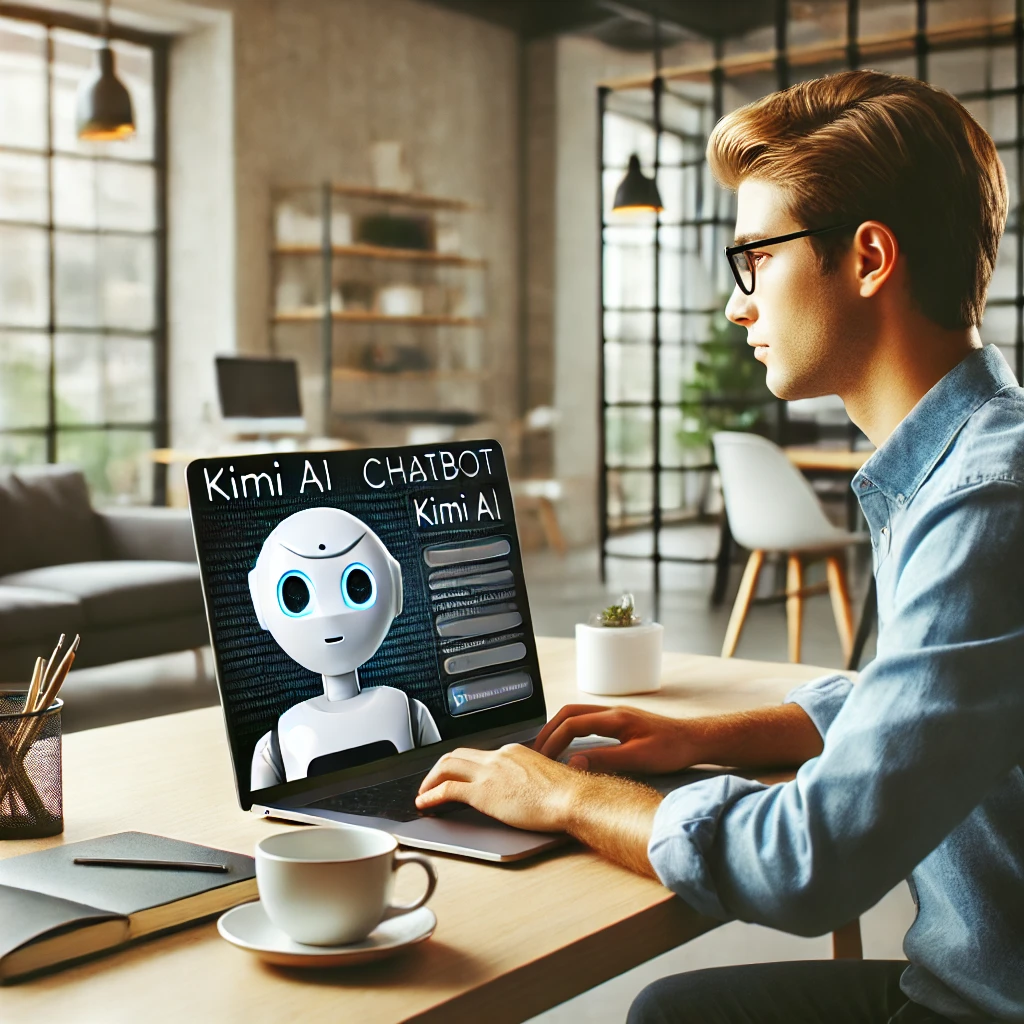Kimi AI: The Underrated Chatbot You Need to Try
Kimi AI has transformed how I interact with technology in ways I never thought possible just a few years ago.
The extraordinary capabilities of this underappreciated chatbot continue to astound me each time I use it for complex tasks that once required hours of manual effort.
When I first discovered Kimi AI, I was skeptical about whether it could truly understand context and nuance the way other premium AI assistants claim to.
The intelligence behind Kimi AI’s processing capabilities represents a monumental leap forward in how machines comprehend and respond to human requests across multiple domains simultaneously.
After integrating Kimi AI into my daily workflow, I’ve experienced productivity gains that would have seemed implausible before experiencing this technology firsthand.
The intuitive interface combined with powerful backend algorithms makes Kimi AI accessible to beginners while offering depth that satisfies technical professionals with stringent requirements.
What truly sets Kimi AI apart from competitors is its unique approach to contextual understanding, allowing it to maintain conversation threads across complex topics without losing track.
As we explore the remarkable features and real-world applications of this groundbreaking chat ai assistant, you’ll understand why early adopters consider it indispensable for modern productivity.
We strongly recommend that you check out our guide on how to take advantage of AI in today’s passive income economy.
Table of Contents
The AI Revolution: Processing Power Beyond Imagination
Imagine handling fifty detailed resumes scattered across your desk—the traditional approach would consume hours of focused attention and mental energy.
Kimi AI transforms this scenario completely by processing all fifty documents in mere seconds, extracting relevant information while filtering out noise automatically.
The processing capabilities extend far beyond simple text recognition, as Kimi AI comprehends document structure, identifies key qualifications, and even evaluates communication style from writing samples.
What impresses me most is how this ai chat platform handles virtually any file format without hesitation—Excel spreadsheets, PDF documents, Word files, and even complex PowerPoint presentations with embedded media.
The technical infrastructure supporting Kimi AI allows it to process documents containing up to 200,000 characters—roughly equivalent to Leo Tolstoy’s “War and Peace”—while maintaining comprehension of themes, characters, and narrative arcs.
For researchers and academics, this represents a paradigm shift in literature review processes, enabling comprehensive analysis of entire books in the time it previously took to skim a single chapter.
This processing capability extends to visual recognition tasks that once challenged even sophisticated algorithms, like distinguishing between similar objects such as blueberry muffins and small dogs with surprisingly similar visual profiles.
The neural networks powering Kimi AI have been trained on diverse datasets that enable it to recognize subtle differences in texture, shape, and context that define distinct objects despite superficial similarities.
Superhuman Search Capabilities
Kimi AI’s search functionality operates at a scale and speed that fundamentally changes how we approach information gathering and synthesis from vast data repositories.
When tasked with finding specific information, this advanced chat ai can simultaneously search through over 1,000 web pages, evaluating content relevance and authority while filtering misinformation.
The sophisticated algorithms allow Kimi AI to understand search intent beyond keywords, recognizing conceptual relationships that might connect seemingly unrelated topics through invisible semantic threads.
During my testing, I challenged Kimi AI with increasingly obscure queries that would typically require multiple refined searches and deep diving into specialized forums or academic databases.
The ai chat assistant consistently surprised me by returning precisely what I needed, often discovering connections between topics that I hadn’t considered but proved invaluable to my research.
For professionals working in specialized fields, Kimi AI effectively functions as a research assistant that never sleeps, continuously scanning new publications and identifying relevant developments in real-time.
The contextual understanding built into the system means searches become increasingly personalized over time as Kimi AI learns individual preferences, professional interests, and information consumption patterns.
This adaptive learning creates an upward spiral of efficiency where each interaction improves future search quality, creating a genuinely symbiotic relationship between human intent and machine execution.
Practical Applications in Everyday Life
The technological sophistication behind Kimi AI translates into practical applications that solve everyday problems with remarkable efficiency and minimal friction.
When I photographed my refrigerator contents before grocery shopping, Kimi AI identified every ingredient—including partially visible items behind containers—and suggested recipes utilizing those ingredients to minimize food waste.
This functionality extends beyond kitchen management to wardrobe organization, where the ai chat can catalog clothing items, suggest outfit combinations, and even track wearing frequency to optimize closet space.
The personal finance applications prove equally impressive, with Kimi AI analyzing spending patterns from uploaded bank statements and identifying optimization opportunities that saved me hundreds of dollars monthly.
For parents juggling multiple responsibilities, Kimi AI functions as an educational assistant that can explain complex homework concepts at appropriate developmental levels while tracking academic progress over time.
Health monitoring represents another domain where this technology excels—Kimi AI can analyze food diary entries, exercise logs, and even sleep data to provide holistic wellness insights previously requiring multiple specialized applications.
The accessibility features deserve special mention, as Kimi AI provides unprecedented digital assistance for individuals with disabilities through customized interfaces adapting to unique interaction requirements.
By seamlessly integrating into existing digital ecosystems, Kimi AI amplifies the effectiveness of other tools rather than creating platform dependencies that limit flexibility.
Revolutionizing Professional Workflows
The impact of Kimi AI on professional productivity extends far beyond simple automation, fundamentally reimagining workflows across diverse industries and specializations.
When implemented in legal practices, this chat ai assistant can review thousands of case documents, identifying precedents and potential arguments while flagging inconsistencies that might otherwise remain undiscovered until trial.
Healthcare professionals report diagnostic assistance that correlates symptoms across medical literature, suggesting potential conditions for physician review while maintaining appropriate boundaries regarding final medical decisions.
Software development teams leverage Kimi AI for code debugging processes that previously consumed days of engineering time, with the assistant identifying logical errors and suggesting optimizations based on established best practices.
Marketing professionals utilize the platform’s content analysis capabilities to evaluate campaign messaging across cultural contexts, identifying potential misinterpretations before materials reach public distribution channels.
Financial analysts employ Kimi AI to process quarterly reports across entire market sectors, extracting performance metrics and identifying trends that inform investment strategies with previously unattainable comprehensiveness.
Educational institutions implement customized versions of the chat ai to provide personalized learning experiences at scale, adapting presentation methods to individual student learning styles while maintaining consistent educational outcomes.
The democratization of these capabilities through Kimi AI’s accessible interface means small businesses can now leverage analytical capabilities previously available only to enterprises with substantial technology budgets.
Visual Recognition Capabilities That Astonish
Kimi AI’s visual processing systems represent a quantum leap beyond previous generations of image recognition technology, approaching human-level understanding of complex visual scenes.
When I tested the system with photographs from a local farmer’s market, Kimi AI identified not just vegetable varieties but assessed freshness based on subtle color variations and surface characteristics invisible to casual observation.
The geographical location capabilities proved equally impressive during my travels, with the ai chat instantly recognizing landmarks and providing historical context for street scenes from various international locations.
Architectural applications demonstrate particular promise, with professionals using Kimi AI to analyze structural designs for potential weaknesses or inefficiencies based on visual pattern recognition trained on thousands of successful projects.
In retail environments, the technology enables instant inventory assessment through simple smartphone photographs, counting stock levels and identifying misplaced merchandise without manual scanning processes.
Security applications benefit from Kimi AI’s ability to distinguish between normal activity and potential concerns in surveillance footage, dramatically reducing false positives while maintaining vigilance for genuine issues.
The accessibility implications extend to visually impaired users, who leverage Kimi AI’s scene description capabilities for navigational assistance and environmental awareness beyond what traditional tools provide.
Perhaps most impressively, these visual capabilities operate with minimal processing requirements, functioning effectively on standard consumer hardware without specialized accelerators or cloud dependencies.
Personalized Recommendations and Analysis
The recommendation engines powering Kimi AI move beyond simplistic correlation models to develop genuinely intuitive understanding of individual preferences across multiple domains simultaneously.
When dining at unfamiliar restaurants, I’ve watched Kimi AI analyze menu offerings against my established preferences, dietary restrictions, and even current nutritional needs to suggest optimal selections.
The technology extends this capability to entertainment recommendations that consider mood, available time, and thematic preferences rather than relying solely on genre-matching algorithms common to streaming platforms.
Product comparison represents another area where Kimi AI excels beyond conventional systems, evaluating features against individual usage patterns rather than generic specification comparisons.
For frequent travelers, the assistant provides personalized itinerary recommendations balancing expressed interests against practical constraints like transportation logistics and attraction operating hours.
Professional development paths receive similar personalization, with Kimi AI analyzing career trajectories against current skill portfolios to recommend specific learning opportunities with maximum impact potential.
The financial advisory capabilities deserve particular attention, as Kimi AI evaluates investment options against stated goals, risk tolerance, and time horizons without the conflicts of interest inherent in commission-based recommendations.
Throughout all these domains, the chat ai maintains comprehensive privacy protections, processing personal data locally whenever possible and employing encryption for necessary cloud operations.
Transforming Creative Processes
Beyond analytical applications, Kimi AI serves as an invaluable creative partner across artistic domains from writing to visual design and musical composition.
Writers experiencing creative blocks find Kimi AI offers thoughtful prompts based on established narrative structures while avoiding predictable suggestions that might lead to derivative work.
Visual artists utilize the platform to explore stylistic variations, with the ai chat generating alternative approaches to composition, color theory, and technique based on established artistic traditions.
Musicians collaborate with Kimi AI to develop melodic variations, harmonic progressions, and orchestration options that expand creative possibilities while maintaining individual artistic voice.
The technology proves particularly valuable during collaborative creative processes, where Kimi AI functions as a neutral facilitator translating between different creative vocabularies and conceptual frameworks.
Content creators developing material for diverse audiences leverage Kimi AI’s cultural sensitivity analysis to ensure messaging resonates appropriately across demographic and geographic boundaries.
For marketing professionals, the assistant generates multiple creative directions based on brand guidelines, campaign objectives, and target audience characteristics without the groupthink common to traditional brainstorming sessions.
Throughout these creative applications, Kimi AI maintains a careful balance—offering sufficient guidance to overcome obstacles while preserving the human creativity that gives work authentic connection and meaning.
Coding Assistance and Technical Learning
Professional developers and coding enthusiasts alike discover unprecedented productivity through Kimi AI’s technical assistance capabilities that extend far beyond simple syntax checking.
When facing challenging implementation problems, I’ve watched Kimi AI suggest architectural approaches that balance performance requirements against maintainability concerns with remarkable sophistication.
The system excels at identifying potential edge cases and security vulnerabilities that might otherwise remain undiscovered until production deployment causes real-world consequences.
Learning new programming languages becomes remarkably efficient with Kimi AI providing contextual examples that build intuitively on existing knowledge rather than following predetermined tutorial paths.
The assistant proves particularly valuable when working with unfamiliar APIs, analyzing documentation to suggest implementation approaches optimized for specific use cases and performance requirements.
Legacy code maintenance benefits tremendously from Kimi AI’s ability to analyze older codebases, explaining implementation decisions and suggesting modernization approaches that preserve essential functionality.
For team environments, the chat ai facilitates knowledge transfer between specialists, translating domain-specific concepts into accessible explanations that bridge communication gaps between technical disciplines.
The educational applications extend beyond professional development, with students learning programming concepts through interactive challenges where Kimi AI provides graduated hints that develop problem-solving skills rather than simply providing solutions.
The Broader Implications for Society
As Kimi AI and similar technologies achieve widespread adoption, we must thoughtfully consider the broader societal implications beyond individual productivity enhancements.
Educational access represents one of the most promising potential impacts, with AI assistants like Kimi democratizing knowledge previously confined to elite institutions or specialized training programs.
The workforce considerations require careful navigation, as organizations must balance efficiency gains against meaningful human employment, ideally redirecting human talent toward higher-value creative and strategic functions.
Privacy frameworks continue evolving alongside these technologies, with Kimi AI implementing progressive data protection measures that establish important precedents for the broader industry.
Cognitive augmentation rather than replacement emerges as the optimal paradigm, with chat ai systems enhancing human capabilities while preserving the judgment, creativity, and ethical reasoning uniquely suited to human consciousness.
The accessibility implications deserve particular attention, as Kimi AI enables digital participation for individuals previously excluded by traditional interfaces designed around narrow interaction paradigms.
Environmental considerations include both challenges and opportunities—while AI systems require significant computational resources, they also enable efficiency optimizations that reduce overall resource consumption across multiple sectors.
By approaching these considerations thoughtfully, we can harness the extraordinary capabilities of technologies like Kimi AI while mitigating potential downsides through intentional design and deployment strategies.
Conclusion: Embracing the Future Today
Kimi AI represents not just incremental improvement but a fundamental shift in how we interact with technology and information in our personal and professional lives.
The capabilities we’ve explored throughout this examination merely scratch the surface of what becomes possible when sophisticated AI assistants become fully integrated into our daily workflows and decision processes.
Forward-thinking professionals across industries are already discovering competitive advantages through early adoption, developing expertise in human-AI collaboration that will define successful careers in coming decades.
The learning curve associated with mastering Kimi AI proves surprisingly gentle despite the sophisticated capabilities, with most users reporting significant productivity gains within days of implementation.
For organizations contemplating digital transformation initiatives, chat ai integration offers an accessible entry point that delivers immediate returns while building foundational capabilities for more advanced implementations.
Individual professionals find Kimi AI particularly valuable for continuous learning, with the assistant functioning as both guide and accountability partner through professional development journeys.
As we stand at this technological inflection point, the question becomes not whether to incorporate these capabilities, but how quickly we can adapt our processes to leverage the extraordinary potential they represent.
The future of human-AI collaboration has arrived through platforms like Kimi AI—those who embrace these capabilities thoughtfully will define the next generation of innovation across every domain of human endeavor.

We strongly recommend that you check out our guide on how to take advantage of AI in today’s passive income economy.




